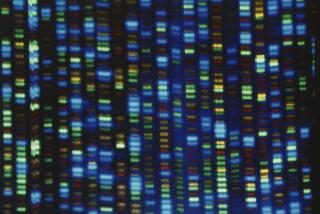Blood Tests Helping to Reconstruct Family Trees
- Share via
With two tablespoons of blood drawn from each of 100,000 volunteers worldwide, Brigham Young University researchers hope to create a DNA database that will use genetic markers to help reconstruct family trees going back 15 generations.
Officials with the high-tech genealogy project have traveled to Southern California a few times over the last year to collect blood from people who can trace their family histories back at least four generations.
In its next search for area volunteers, the team will come to the Orange County Fair. From July 21 to July 26, researchers will be at the genealogy booth, hand out information and family history forms, and make appointments to take blood samples at locations throughout Orange County.
It will take five years and millions of dollars to complete the Molecular Genealogy Research Group’s database of DNA samples and matching family trees. Once done, researchers say they will be able to tell most people, from a blood test, where and when their genes have resided over the last 300 years.
“Our goal is to create the world’s largest collection of genetic and genealogical information,” said Scott R. Woodward, a Brigham Young microbiology professor and project director, “and then put that information into a database that can be used for understanding our connections with each other.”
Woodward said the research is being done independently of the Church of Jesus Christ of Latter-day Saints, a major backer of genealogical work and the church with which Brigham Young University is affiliated. Hundreds of Mormons have volunteered to help with the project. Mormons believe that “vicarious baptisms for the dead” can be done to unite deceased relatives who were not originally church members with their family through eternity.
Nearly 25,000 blood samples have been collected in little more than a year. Researchers say they hope to obtain 200 samples from each of 500 communities throughout the world.
Project officials began with members of genealogical societies, Mormons and others who already had extensive written family histories, dating back as far as 800 years.
Once the sampling is finished, scientists will be able to pinpoint when a particular strand of DNA from almost anyone--and therefore a potential ancestor--resided in a particular village, even without a written family history.
But people who use the database will not be able to immediately find out the names of distant relatives because identifying information will not be made available. They will be able to find out that, for example, someone with their genetic markers was in Madrid in 1874, or was in Cairo in 1790.
“The whole concept of DNA tracing in genealogy is very exciting and will let us solve long-standing mysteries,” said Michael Leclerc with the New England Historic Genealogical Society. “It’s a double-edged sword, however. There’s also potential to disprove lineages, too.”
Brigham Young researchers are aware of the fears that come with having a central agency in possession of a huge database of DNA fingerprints. Woodward says they have tried to overcome that by setting up a system of anonymity in which codes, locations and dates take the place of family names.
The project is using more than 250 genetic markers to identify ancestry. The projected cost for the markers alone is in the neighborhood of $25 million, though new technology could substantially reduce that bill.
The university project is primarily funded by two philanthropists, Utah medical products entrepreneur James L. Sorenson and Ira Fulton of Arizona.
“As corny as it sounds, the reason they got involved in this project is to show how connected we all are,” Woodward said. “The words they use over and over again to describe what the research promotes are unity, brotherhood and understanding.”
More to Read
Sign up for Essential California
The most important California stories and recommendations in your inbox every morning.
You may occasionally receive promotional content from the Los Angeles Times.













